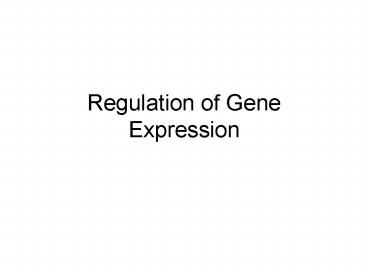Regulation of Gene Expression - PowerPoint PPT Presentation
1 / 19
Title:
Regulation of Gene Expression
Description:
The role of repressor genes in operons. ... turn the inducible operon on, an inducer binds to and inactivates the repressor protein. ... – PowerPoint PPT presentation
Number of Views:173
Avg rating:3.0/5.0
Title: Regulation of Gene Expression
1
Regulation of Gene Expression
2
You Must Know
- The functions of the three parts of an operon.
- The role of repressor genes in operons.
- The impact of DNA methylation and histone
acetylation on gene expression. - The role of oncogenes, proto-oncogenes, and tumor
suppressor genes in cancer.
3
Bacteria respond to environmental change by
regulating Transcription.
- Genes are clustered into units called operons.
- 3 parts of an operon
- Operator- controls the access of RNA polymerase
to the genes. - Promoter-where the RNA polymerase attaches.
- Genes- The entire stretch of DNA required for al
the enzymes produced by the operon.
4
General structure of an OPERON
5
Regulatory Genes
- Produce repressor proteins that may bind to the
operator site. - When they occupy the operator site, RNA
polymerase is blocked from the genes of the
operon. - This means the operon is off.
6
Repressible Operon
- Is normally on but can be inhibited.
- Is Anabolic, building an organic molecule.
- The repressor protein produced by the regulatory
gene is inactive. - If the organic molecule that is produced is
provided to the cell, the molecule can act as a
corepressor and bind to the repressor protein,
activating it.
7
Inducible Operon
- Normally off, but can be operated.
- Normally catabolic, breaking down food molecules
for energy. - To turn the inducible operon on, an inducer binds
to and inactivates the repressor protein. - Now RNA polymerase can access the genes of the
operon.
8
Regulation of Genes
- The expression of Eukaryotic genes can be turned
off and on at any point along the path to
becoming a protein. - Different cell types are due to differential gene
expression, the expression of different genes by
cells with the same genome.
9
Packaging of DNA
- A nucleosome is a packaging unit of DNA.
- Consists of DNA bound ot small proteins called
histones. - The more tightly bound DNA is to its histones,
the less accessible it is for transcription. - This relationship is governed by 2 chemical
reactions. - DNA methylation- the addition of Methyl groups to
DNA - Causes DNA to become more tightly packaged, thus
reducing gene expression. - Histone acetylation- acetyl groups are added to
amino acids of histone proteins, making the
chromatin less tightly packaged, encouraging
transcription.
10
Recap
- Methylation- occurs on DNA reduces gene
expression - Acetylation- occurs on histones increases gene
expression
11
Other factors of Gene expression
- Transcription initiation is another important
control point in gene expression. - The control of gene expression may also occur
prior to translation and just after translation,
where proteins are processed.
12
Connection to real life
- Cardiovascular disease
- Gene expression provides valuable, tissue and
cell-specific information about the molecular
mechanisms involved in disease processes,
allowing a clinician to, for example, evaluate
cardiovascular disease state, activity, and/or
progression at a point in time.
13
Links
- http//web.mit.edu/bioedgroup/animations.htm
14
A program of differential gene expression leads
to the different cell types in a Multicellular
organism.
- Zygote undergoes transformation through three
interrelated processes. - Cell division
- Cell differentiation- cells specialize
- Morphogenesis- organization of cells into tissues
and organs.
15
What controls differentiation Morphogenesis?
- Cytoplasmic Determinants
- Maternal substances in the egg that influence the
course of the early development. - They are unevenly distributed in the early cells
of the embryo and result in different effects. - Cell-cell signals
- Results from molecules, such as growth factors
produced by one cell influencing neighboring
cells, a process called induction which causes
cells to differentiate.
16
- Determination
- Series of events that lead to observable
differentiation of a cell. - Differentiation is caused by cell-cell signals
and is irreversible. - Pattern Formation
- Sets up the body plan and is a result of
cytoplasmic determinants and inductive signals. - Determines head and tail, left and right, back
and front. - Uneven distribution of morphogens plays a role in
establishing these axes. - Stem Cell Animation
17
Cancer Results from genetic changes that affect
cell cycle control.
- Oncogenes- are cancer-causing genes.
- Proto-oncogenes- genes that code for proteins
that are responsible for normal cell growth. - Become oncogenes when a mutation occurs that
causes an increase in the product of the
proto-oncogene, - Or
- an increase in the activity of each protein
molecule produced by the gene.
18
- Cancer can be caused by a mutation in a gene
whose products normally inhibit cell division. - These genes are called tumor-suppressor genes.
- Cancer development is based on the idea that
cancer results from the accumulation of mutations
that occur throughout life. - The longer we live, the more mutations that are
accumulated and the more likely that cancer might
develop.
19
Activities
- This weeks CAR
- What does Stem cell Research Mean to you?
- Different types of Stem Cells?
- How are they cultured in the lab?
- What are some issues in Stem cell research?
- What are some issues that you have?































